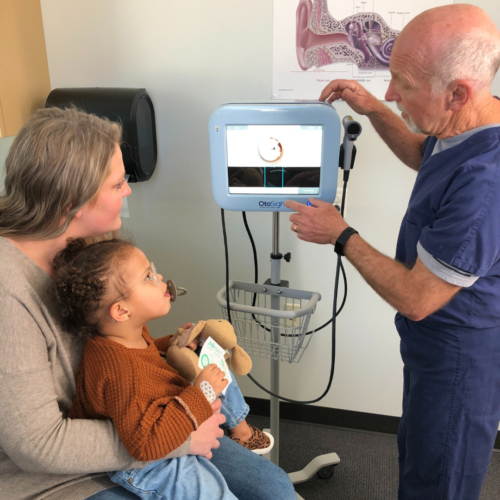Phone
866-411-EARS
Address
PhotoniCare Inc.
2800 Meridian Parkway, Suite 175
Durham, NC 27713

Middle ear infections, or otitis media, are very common. So common, in fact, that 90% of children will suffer from an ear infection in their childhood. You may notice your child being more fussy than usual, tugging on their ear and grimacing, or complaining about a sharp pain in the ear. These are all common ear infection systems which often lead a parent to take their child to a healthcare provider.
Because ear infections are the most common ailment among kids it can cost a significant amount to the consumer and the health care system. With healthcare expenses on scrutiny now more than ever, we break down the real cost for ear infections, and how our technology will empower healthcare providers to make better decisions, and reduce costs exponentially.
By the Numbers
If a parent brings their child into the office to see a healthcare provider, hits to the pocketbook begin to escalate:
In addition to an office visit, there are many parents who take their child for ear pain treatment to urgent care or the emergency room. Debt.org reported on an Annals of Internal Medicine study that found the average cost of an urgent care visit for three common illnesses — middle ear infection, pharyngitis and urinary tract infection — was $155. Other estimates place the average urgent care visit at anywhere from $71 to $125. There are also instances where a parent may take their child to the emergency room for ear pain. Debt.org reports that an average emergency room visit for ear pain can cost an average of $400.
Antibiotics
Besides being so prevalent among children, ear infections are also the leading cause of antibiotic over-prescription and antibiotic resistance development. Antibiotics play an important role in fighting infection, but when prescribed inappropriately, such as for viral infections or a non-bacteria related middle ear problem, the correct course of treatment is delayed, and the potential for unrelated bacteria to develop resistance to the prescribed antibiotic(s) can become a problem.
Antibiotics also come with a price tag for parents:
Devices like OtoSight Middle Ear Scope will allow your healthcare provider to image the contents of the middle ear– providing key access to the information needed for a correct diagnosis and the first step in being a good Antibiotic Steward and reducing costs, both to you and the healthcare environment!
Surgery
For some children, the next best step in managing your child’s ear health is the placement of tubes within the eardrum. About 700,000 children each year have ear tubes surgically placed, according to the American Academy of Otolaryngology-Head and Neck Surgery. Ear tubes typically cost around $2,000-5,000 for people with insurance.
Diagnosing Ear Infections
The American Academy of Pediatrics AOM guidelines state that fluid must be present in the middle ear to definitively diagnose Acute Otitis Media (AOM). This buildup of fluid and pressure in the middle ear is the direct result of a microbial infection that would, in many cases, be treated with antibiotics. However, determining if there is fluid in the middle ear is difficult today because the tools currently available measure or view the eardrum only, rather than measuring the potential fluid directly. In the current paradigm of care, the eardrum is observed as a proxy for middle ear health.
Current tools used to diagnose fluid in the middle ear can be difficult to use reliably in squirming or crying children, and rely heavily on user expertise to interpret a simple image or measurement of the eardrum. In the primary care setting, otoscopic accuracy has been reported to be as low as 50%. By the numbers, half of all children are not given an accurate diagnosis. The result? Increased costs for payers and over prescription of antibiotics for the patient.
PhotoniCare’s mission is to make a real impact on the health of children – that’s why we started with middle ear infections. Our goal with our first product, the OtoSight Middle Ear Scope, is to revolutionize the diagnosis, treatment, and monitoring of middle ear infections.
The Future of Diagnosing Ear Infections
The technology harnessed by the OtoSight Middle Ear Scope is a quantum leap over the current standard, in that OtoSight Middle Ear Scope can actually see evidence of disease in the middle ear. All other technologies on the market are using the eardrum as a proxy to diagnose middle ear disease – this methodology is inherently problematic as it does not reflect accurately enough the actual condition of the middle ear. In other words, you get what you see – OtoSight Middle Ear Scope technology allows healthcare providers to actually see the contents of the middle ear, such as fluid, and this is the first step in diagnosing middle ear disease accurately. No proxies, no guessing.
The OtoSight Middle Ear Scope has the potential to fundamentally transform the diagnosis and treatment of middle ear infection. It could improve the quality of care for one billion children worldwide, empower healthcare providers to make better decisions, and reduce costs exponentially. We are so excited to get this technology out to patients as soon as possible. Thanks, as always, for being part of our journey.

The COVID-19 pandemic has created numerous challenges for parents. Navigating… Read More

PhotoniCare sits down with Dr. Michael Novak, an Ear, Nose… Read More

This week on the #EnginEarGuys blog we talk about otolaryngology… Read More